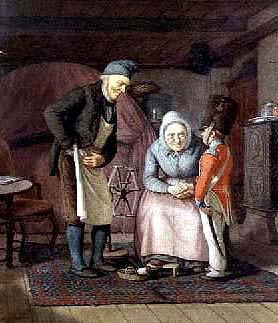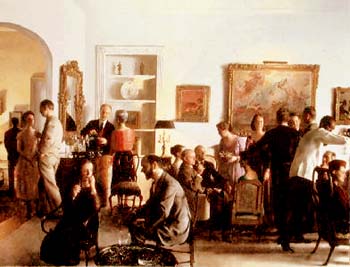 |
Formation of Children
Proper Behavior for Visits
Marian T. Horvat, Ph.D.
Social relations are a necessity for human life and at times, a sweet salve for its troubles. We should leave our homes not only for business and recreation, but also to visit our friends, to tighten relations with relatives, and to fulfill civil and religious duties with the constituted authorities.

A youth visits his grandparents before his First Communion |
In societies where the Catholic spirit reigns, yet other duties impose themselves: visiting the sick, and offering assistance to the poor, the elderly, and widows
The principal events in the life of the family – births, baptisms, First Communion, marriages, anniversaries, or deaths – are other occasions when our relatives are grateful to receive moral and spiritual expressions of support and amity by our sincere participation in the joys and sorrows of life.
Young children should not make visits unless they are accompanied by some other person of their family. The time for the visit should be established in advance and correspond to the convenience of the person visited.
In small towns and among related persons or close friends, it is sufficient to dress in one’s daily attire. Today, because of our bad customs, it is necessary to note that daily attire should always be dignified, clean and modest. A young man should not visit his grandmother in sports shorts and a T-shirt. On other more formal occasions or when visiting persons outside the familiar circle, he should present himself well dressed, in accordance with the circumstances. If the reception is ceremonious, a suit and tie should be worn.
The calling card of the past

A gentleman checks the calling cards on his return
Painting by William Fitz |
In the past, there was the charming custom of the calling card. Some of our young readers may have never even heard of such a thing. This European-style custom was followed in the better homes of the American East and South even until the 1950s or ‘60s, when the Law of the Casual began to impose its despotic reign everywhere. Nonetheless, with the hope that some day such customs might be revived, we record the briefest summary of the workings of the calling card.
It was customary for a visitor to present oneself at the door, and leave with the maid a calling card who placed it on a table in the vestibule established for that purpose if the person were not in. There were strict rules governing the card’s size and the engraving. If, after some rings, no one appeared at the door, the visitor would leave his calling card.
When a maid or doorman appeared, the visitor would ask, “Is Mr. X or Mrs. Y available?” If the response were affirmative, the person entered and accompanied the maid to the visitors’ hall. The umbrella or cane was always left in the vestibule, as well as the hat and the overcoat, if the weather demanded their use. Once in the salon, if left alone, he took a correct attitude, avoiding touching objects, pictures, albums, photographs, the piano, and so on. In the days of the ceremonious reception, the young man would kiss the hand of the lady of the house should she appear.
If the response were negative, he did not insist. He left his visiting card, writing some few amiable words on it expressing his regret for having missed the person.
The art of presentation
Entering a room where many other guests or persons of the house are seated, the visitor shakes hands with his host or hostess, makes a slight inclination of greeting to the others present, and gives a handshake to the men he knows. Then, with all calm, he will take a seat, avoiding choosing the most comfortable unless he is invited to do so. This maneuver of entering a salon demands experience and confidence, which are the supreme rules.
Those accustomed to society know the art of presentation. From youth, a boy should learn to conquer his natural timidity that can make him awkward in social situations. Once he enters the room and acknowledges the hostess, he should know how to enter into conversations naturally with those around him. At a small gathering, the host or hostess will introduce the guests to each other. This is not done on formal occasions when a great many persons are present. To be invited to be under a friend’s roof is already supposed to be an introduction to those it shelters.

The conversation at social gatherings normally is amiable and genteel |
In small gatherings, it is necessary for the youth to rise each time a lady or an elderly person enters the room, or if someone comes to him to present his farewell.
It would be discourteous at a social gathering, visit or reception in a private home to not speak with the others present or to assume a severe, glacial or pedantic attitude. This could cause discomfort to the host or other visitors. Likewise, it is disagreeable to be too familiar. One of the worst habits is to pat, nudge or take hold of people when conversing with them.
If by chance two persons who have estranged relations meet at the same gathering, the one who arrived last should retire discreetly after a short while, without, however, raising notice, It is always bad taste to let others know that enmities exist against us in society, and in particular we should keep this veiled from the eyes of the one we are visiting.
A young man’s language should always be respectful, as elegant as possible, and circumspect, revealing that he is well-bred. Street terms and expressions, a general sign of vulgar ways and lack of politesse, should never be used among ladies and gentlemen.
To know how to listen
Reserve and circumspection will save one’s reputation from irreparable shipwreck. The young man who knows how to listen and reflect before speaking will certainly be amiably accepted in society. A youth should listen and learn from those with more courteous and fine forms of language, and then follow their good example. He should avoid the imperious and arrogant tones that cool friendships and raise antipathies.
During a visit or amiable gathering, discussions that are too lively and sharp should be avoided. A visit is not a debating hall. A veil of amiability should be drawn over all expositions of ideas and facts. A well-bred man knows how to show interest in the conversation of those present and to contribute to it at opportune times with his reserve of knowledge. If he does not know anything about a topic, he should remain silent. Only the fool enters into literary or scientific jousts without the proper training or knowledge.
Avoid the open contradiction of, strong censure of, or gossip about those who are not there. It is cowardice to attack an absent person who cannot defend himself or retaliate.


Related Topics of Interest
 Proper Behavior for Visits - II Proper Behavior for Visits - II
 Introduction to the Small Manual of Civility Introduction to the Small Manual of Civility
 Chapter 16: The Braggart Chapter 16: The Braggart
 Chapter 17: The Value of Distinction Chapter 17: The Value of Distinction
 Chapter 18: Let's Not Forget the Greeting Chapter 18: Let's Not Forget the Greeting
 Chapter 19: The Blessing Chapter 19: The Blessing
 Chapter 20: The Family Milieu Chapter 20: The Family Milieu
 Chapter 21: A Youth's Relations with His Superiors Chapter 21: A Youth's Relations with His Superiors

Related Works of Interest
|
|
Formation | Cultural | Home | Books | CDs | Search | Contact Us | Donate

© 2002- Tradition in Action, Inc. All Rights Reserved
|
 |
|